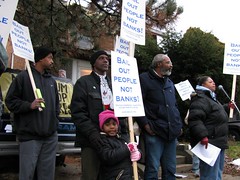
Moratorium Now! Coalition rally outside the home of Anthony King on the west side of Detroit. Sandra Hines speaks at the microphone demanding the reversal of the foreclosure of the King home. PANW editor Abayomi Azikiwe next to Hines. (Photo: Alan Pollock
Originally uploaded by Pan-African News Wire File Photos
U.S. foreclosures up 24% in 1st quarter
By ALAN ZIBEL
ASSOCIATED PRESS
WASHINGTON— The number of American households threatened with losing their homes grew 24% in the first three months of this year and is poised to rise further as major lenders restart foreclosures after a temporary break, according to data released today.
The big unknown for the coming months, however, is President Barack Obama’s plan to help up to 9 million borrowers avoid foreclosure through refinanced mortgages or modified loans.
The Obama administration expects its plans to make a big dent in the foreclosure crisis. But it remains to be seen whether the lending industry will fully embrace it, despite $75 billion in incentive payments.
The faltering economy is causing the housing crisis to spread. Nationwide, nearly 804,000 homes received at least one foreclosure-related notice from January through March, up from about 650,000 in the same time period a year earlier, according to RealtyTrac Inc., a foreclosure listing firm.
In March, more than 340,000 properties were affected, up 17% from February and 46% from a year earlier.
Foreclosures “came back with a vengeance” last month and are likely to keep rising, said Rick Sharga, RealtyTrac’s senior vice president for marketing.
Nearly 191,000 properties completed the foreclosure process and were repossessed by banks in the quarter. While the number was down 13% from the fourth quarter of last year, it is expected to rise through the summer and then possibly taper off.
Fannie Mae and Freddie Mac, the big mortgage finance companies, together with many banks had temporarily halted foreclosures in advance of Obama’s plan. Now armed with the details about which borrowers can qualify, the mortgage industry has begun foreclosing on ineligible borrowers.
The Treasury Department has signed contracts with six big loan servicing companies — including Citgroup, Wells Fargo and JPMorgan Chase. Many have already started processing loans as part of the government’s “Making Home Affordable” plan.
“We need to get the long-term solutions for these folks,” Shaun Donovan, Obama’s housing secretary, said in an interview.
In the coming months, Donovan said, there are still likely to be increased foreclosures, especially from vacant houses, second homes and those owned by speculators. None of those properties will qualify for a loan modification. However, he remained optimistic that overall foreclosures could start to decrease this summer.
But even industry executives who emphatically support the plan emphasize that it’s success isn’t guaranteed.
“The effectiveness of the plan overall obviously is going to depend on the level of industry participation,” said Paul Koches, general counsel of Ocwen Financial, which collects loan payments on subprime loans.
Many borrowers and consumer groups claim the modifications offered by the lending industry don’t do enough to help cash-strapped homeowners, despite more than a year of public prodding from regulators. Fewer than half of loan modifications made at the end of last year actually reduced borrowers’ payments by more than 10%, data released last month show.
Plus, the lending industry has been swamped by the unprecedented wave of calls from distressed borrowers. “You can’t wave a magic wand and make the loans suddenly modified,” Sharga said. “They’re all individual transactions.”
In RealtyTrac’s report, Nevada, Arizona, California and Florida had the nation’s top foreclosure rates. In Nevada, one in every 27 homes received a foreclosure filing, while the number was one in every 54 in Arizona. Rounding out the top 10 were Illinois, Michigan, Georgia, Idaho, Utah and Oregon.
No comments:
Post a Comment